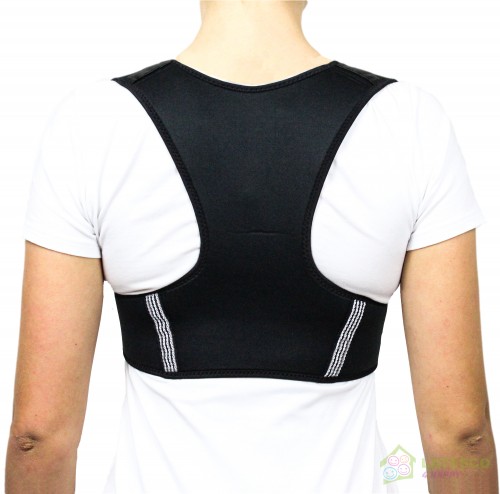
Thoracic Kyphosis: Causes and Risks
Thoracic kyphosis refers to the excessive outward curvature of your upper back, where your thoracic spine is located.
It involves an imbalance between opposing muscle groups in your chest and back, which develops over time from maintaining a rounded, slouched upper back position.
With the muscles in your chest shortened and your upper back muscles overextended, they end up tightening in this position and reforming the shape of your spine.
The good news about thoracic kyphosis caused by bad posture is that it can be reversed assuming you catch it in its early stages.
You want to fix it as early as possible—the longer you have it, the more health problems it can cause, including:
- Hyperlordosis (excessive lumbar curvature)
- Herniated discs caused by increased weight load on your spine [2]
- Neck pain from forward head posture [3]
- Poor blood circulation to the brain
- Increased risk of falls and fractures and reduced mobility as you age [4]
- Higher risk of arthritis [5]
- Fatigue caused by misalignment and poor blood circulation
- Backaches and muscle pain from the strain of trying to stand upright
Braces for Thoracic Kyphosis – Do They Work?

Research has shown that posture braces result in measurable postural improvement for people with thoracic kyphosis, but mainly in adolescents with spinal deformity [6].
While adolescents have the potential to change their form with the help of a brace, studies have revealed that adults can’t experience a significant change in their spinal curvature from a brace.
In a medical study published in Scoliosis, 16 adults with thoracic kyphosis wore posture braces. Their self-rated levels of back pain reduced significantly with the use of the brace, and they experienced better posture and balance. However, their posture without the brace remained the same [7].
That’s not to say thoracic kyphosis can’t be corrected, however.
The best way to fix it is to correct the muscle imbalances involved in the posture. By tightening overstretched back muscles and opening up the shortened muscles in your chest, you can release the hunchback position overtime.
Nonetheless, kyphosis braces can be a great tool for helping you improve thoracic spine health and correct your posture.
Put simply, they brace your back in a more neutral, straight posture. This takes the pressure off your spine and reduces strain in your muscles, so that you can hold a more upright posture without the pain, fatigue and stiffness.
A hunchback position causes muscle tightness and strain, which in turn hardens the hunched posture. The result is a vicious cycle that causes thoracic kyphosis to worsen.
Wearing a posture brace reduces back muscle strain and tightness, so that you can break the cycle.
You can wear the brace while doing your everyday activities, and remove it to perform exercises that help reverse thoracic kyphosis. Then, when you put the brace back on, you can avoid counteracting the corrections you made with the exercises.
Instead of going back to muscle imbalances in which your back muscles are overstretched and chest muscles are shortened, your back will be in a more neutral position, so that the corrections you made can take effect.
What to Look for in a Good Posture Corrector
The best posture corrector will depend on your own needs. If you’re experiencing pain and fatigue from your kyphosis posture, you can probably benefit from a more heavy-duty brace that helps relieve the burden of your weight on your back.
If you want to prevent kyphosis early on and improve your posture before it gets worse, you may like a posture correcting device that helps detect poor posture and remind you to fix it by straightening up.
Here are some features to look out for when shopping for a posture corrector:
Adjustability
If you choose a kyphosis brace, the importance of fit goes without saying. Without adequate adjustability, a brace can’t provide support if it doesn’t fit your form.
Look for a brace that can adjust at as many points as possible for a unique fit.
Comfort
Given that a posture brace should be worn frequently, you need it to feel comfortable enough to wear for long periods, when you’re sitting at a desk, driving or doing manual work.
Braces with padding made of soft foam are great choices for comfort, though they can be a little bulkier than some of the more “strappy” braces that are designed to stay out of sight.
Ease of Use
To ensure you use it often, your posture brace should be easy to get on and off. If it takes a long time to strap on and adjust every time, you may not be as apt to wearing it.
If the brace is easy to wash, that’s also a plus that makes it easier to use.
Breathability
You want your brace to be made with material to prevent sweating and discomfort, especially if it’s designed to be worn against your skin.
Full Back Support
Back braces that only provide upper back support may end up contributing to an unnatural bend in your lower spine known as hyperlordosis.
Those providing full torso support along the length of your spine can help correct or prevent hyperlordosis as you correct kyphosis.
